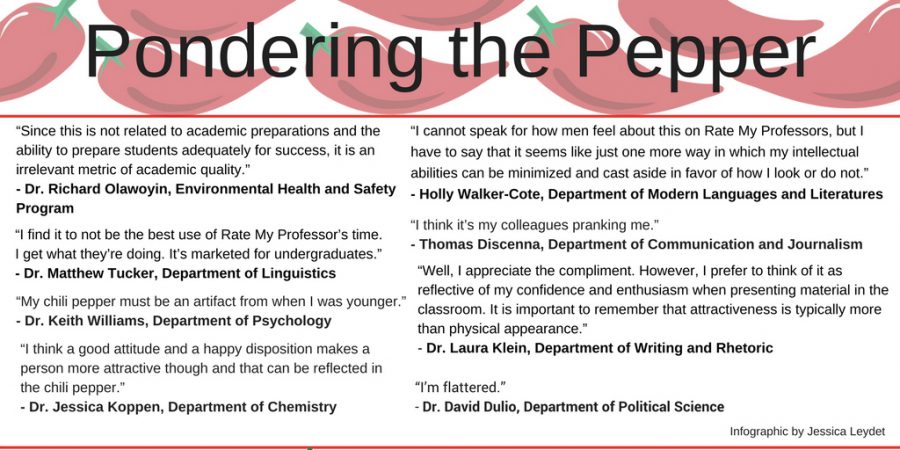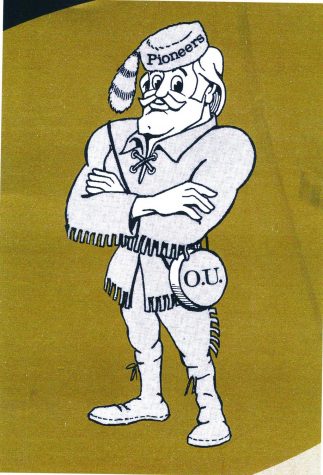Rate My Professors’ Chili Peppers Heat Up Conversation
The “Hottest” professors ponder the pepper
Mixed feelings about a website many students use every semester have been swirling around the different departments on campus. The website Rate My Professors has been up and running since May 1999 and is available for colleges and universities across the United States, Canada and the United Kingdom. Over the years, the site has accumulated more than 19 million ratings on 1.7 million professors and has undergone several changes including rating the school as a whole.
Professors are yet to come to a consensus on if it is useful or a waste of time. Some think the site, when used with caution, can be helpful to select courses because of the student feedback. Others think the self-selected comments and biases of the website’s nature result in a unfair debate about a professor.
“Rate My Professors offers students a way to voice their opinions based on personal experiences,” Laura Klein from Oakland’s Department of Writing and Rhetoric said. “Although Rate My Professors is not designed to measure learning outcomes or formally evaluate instructors, it may provide some insight as to how effectively the professor communicates, clarity of assignments and overall ability to engage students. A student’s perception is his or her reality, so that is difficult to gauge. It simply provides an outlet for students to express what they liked or did not like about a professor or their course.”
Matthew Tucker from Oakland’s Department of Linguistics is neutral when it comes to Rate My Professors. He thinks the site acts as a resource for students to take ownership of their education, but the ratings can be skewed due to a number of influences.
“Certainly it’s not difficult to imagine that there are times when a student will learn better with one professor than with another, even if the material is exactly the same,” Tucker said. “I like that there’s a place where students can access that information. I’m a product of the social media generation.”
There is one aspect of the site that has nothing to do with a professor’s ability to teach, and it is the chili pepper.
This pepper rates a professor’s physical appearance. On the website, it appears right under the professor’s “level of difficulty” and is either fully filled or not filled in at all.
Just like initial thoughts on the website, professors have varying thoughts on this aspect.
Tucker laughed when he found out he had a pepper on his page, but still hopes students take his classes because they find his lectures enjoyable. He went on to explain the halo effect and how people are more likely to be charitable to a person they consider physically attractive.
“I do think appearance matters a lot,” Tucker said. “I would hope that students form their opinions based on the stuff about appearance that denotes professionalism.”
On the other end, some professors do not see the need for a rating on physical appearance. Many just want to share their passion for teaching without feeling self-conscious.
“I like to remind [students] that there is no chili pepper on my resume or CV,” said Holly Walker-Cote form Oakland’s Department of Modern Languages and Literatures. “I feel that this category has a way of undermining my education, skill and experience as an instructor. At this time in our culture, I think this is a very good example of how we treat women, in particular, in our society.”
With the aspect of female professors being treated differently, Tucker can see his female colleagues’ appearance getting brought up more. He’s noticed that his female colleagues’ reviews are sometimes at 50 to 60 percent physical appearance.
“As a man, it’s bewildering to me how much commentary there is about the physical attractiveness of female professors,” Tucker said.
Keith Williams from Oakland’s Department of Psychology also sees this occurrence. He is part of a committee that revises the course evaluation sheets given to students at the end of the semester. In this committee, members discuss how some women get rated lower and critiqued more harshly.
“I know that there is data out there that student ratings are biased against women,” Williams said. “So women, generally speaking, get lower scores than men. I think there are a couple studies that indicate an early impression actually dictates what’s going to be on those [student ratings].”
Williams also explained that there’s a high correlation between positive ratings, likability and attractiveness.
“If you like the instructor and they’re attractive in some way and they’re male, it seems like that individual gets higher ratings,” he said.
The power dynamic between professor and student also comes into play. Professors serve as an authoritative figure with the job to educate. They hold much more responsibility than students.
“If a professor were ever to make comments anywhere about how students look, that person would lose his or her job and never be able to teach again,” Walker-Cote said. “There are very clear boundaries in our culture regarding the student-teacher relationship. The anonymity of this web site has allowed people to ignore those boundaries.”
Professors are not blind to sites like Rate My Professors and know that students use them for a variety of reasons. Whatever the reason may be, professors advise students to read at their own risk and to look for the substance in reviews.
“I would liken planning your classes around Rate My Professors to planning your day around a horoscope in the newspaper; you can do that if you choose, but that doesn’t make it a good plan,” Walker-Cote said.






